It is not easy to shape learning activities in a corporate context. Often it seems necessary to refocus the discussion on the business need and a specific description of what needs to be improved or changed in the behavior of the learner. If we focus our attention only on the training activities we will likely not be able to find the right mix for our blended learning approaches. We need to understand the environmental factors and business drivers for the performance of our learners before we design our blended learning solution.
- Do we onboard new colleagues or do we talk to experts in their field?
- Are we introducing organizational change or product-specific training?
- Is our target group in one location or are they spread out and only meet virtually?
We should aim to understand the driving business objectives before we look at learning objectives for our blended learning approaches. And before we start thinking about our blended approach we should also be as clear as we can about the way we want to measure our success. Do we just count participation and evaluation sheet results or are we really looking at understanding behavioral change? In the end we are only successful if the learner is using the new competency or content in their daily work for the benefit of the company. And this is where a blended learning approach can certainly help (Figure 1).
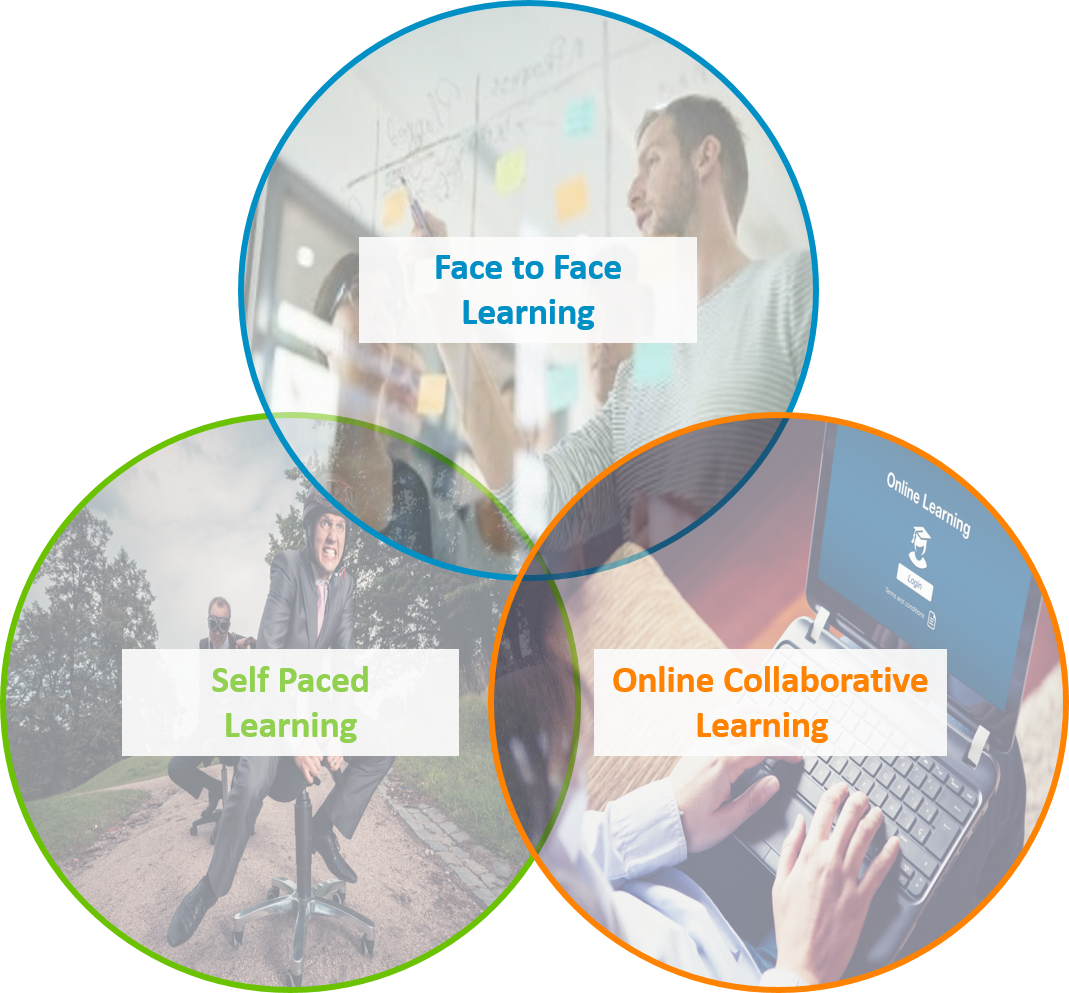
Figure 1:The three elements of blended learning and their overlapping relationship
According to Wikipedia, blended learning is an education program or activity that combines online digital media with traditional classroom methods. It requires the physical presence of both teacher and student, with some element of student control over time, place, path, or pace. Blended learning is also used in professional development and training settings.
Many terms are used interchangeably: “blended learning,” “hybrid learning,” “technology-mediated instruction,” “web-enhanced instruction,” or “mixed-mode instruction.”
The term “blended learning” was initially vague, encompassing a wide variety of technologies and pedagogical methods in varying combinations. In 2006, the term became more concrete with the publication of the first Handbook of Blended Learning by Bonk and Graham. Graham challenged the breadth and ambiguity of the term’s definition, and defined “blended learning systems” as learning systems that “combine face-to-face instruction with computer-mediated instruction.” In a report titled “Defining Blended Learning,” researcher Norm Friesen suggests that, in its current form, blended learning “designates the range of possibilities presented by combining internet and digital media with established classroom forms that require the physical co?presence of teacher and students.”
What is SkillCamp?
SkillCamp is a globally steered marketing and sales learning ecosystem targeting several thousand marketing and sales colleagues across many countries at Bayer’s Crop Science Division. Further details can be found in two previous articles in this magazine, here and here.
As we ventured into implementing our new learning approaches we soon realized that we really needed a common storyline, common mindset, and common language to consistently convey our messages, processes, and ideas. Also we wanted to make our learning stick. A blended approach seemed mandatory.
This is where SkillCamp, as our marketing and sales blended learning and performance support framework, was created. It takes content and customizes general marketing and sales content with the relevant industry details and competency elements and delivers it via a mix of different channels and methods.
So for usm blended learning combines traditional instructor led training (ILT) with a mix of digital activities, combining several proven delivery methods, especially with regard to covering all areas of the 70:20:10 Model for Learning and Development and the Five Moments of Learning Need. In 2017, SkillCamp won the Brandon Hall Gold Award in the category Best Use of Blended Learning.
Why is blended learning critical for a learning ecosystem like SkillCamp?
SkillCamp is designed for all five moments of learning need (according to the theory and concept of Conrad Gottfredson and Bob Mosher) and according to a 70-20-10 approach. The SkillCamp team has developed the following learning formats:
- For the 10 (formal learning; mainly moments of new and more): three-day Classroom foundational training (ILT), virtual instructor-led trainings (VILTs), content deep-dive trainings, and specific expert trainings (ILTs).
- For the 20 (coaching, mentoring; mainly moments of apply, solve, change): Subject matter experts are available for on-the-job coaching and mentoring, community meetings, online community forum, and social media platform integration
- For the 70 (on the job, workplace learning; mainly moments of apply, solve, change): “SkillCamp Online”—our electronic performance support system (EPSS) (see details below)
What are the components we used?
Please see Figure 2.
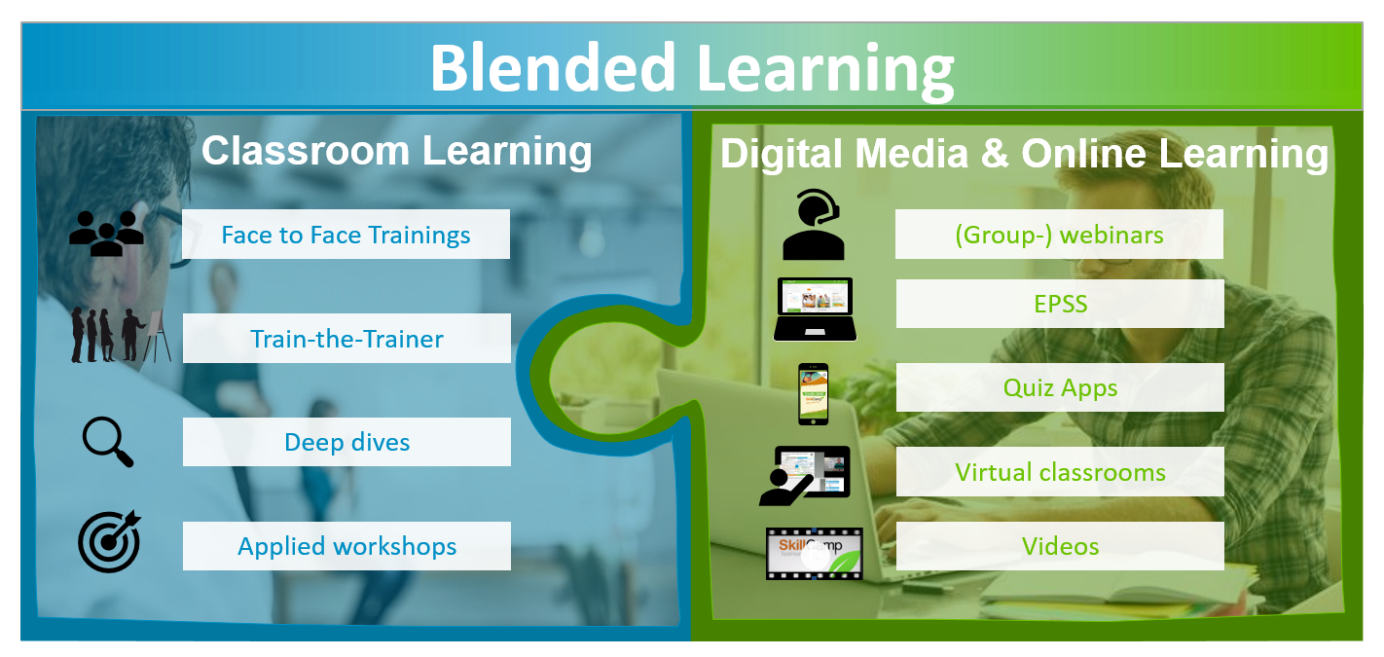
Figure 2:The SkillCamp Online user interface is the single point of reference for users.
Our blended learning approach evolves around SkillCamp Online, our EPSS, which is at the core of the learning framework. Every learning format is designed with and around SkillCamp Online. SkillCamp Online is the single point of reference and truth for commercial excellence knowledge at Crop Science. It is the go-to area to get instant help for workflow issues, to receive the most up-to-date templates, tools, terms, concepts, methods, or examples. In case you are interested: it is currently based on Ask Delphi by KnowHow! AG.
So SkillCamp combines many learning formats in a blended learning approach. All of the formats are computer based or online supported. Below is a brief overview of the components we use in our SkillCamp learning ecosystem:
Instructor-led trainings (ILT)
SkillCamp started with a three-day SkillCamp foundational training rolled out globally in several languages to almost 5,000 colleagues (currently). It integrated many blended learning elements, e.g. performance support and EPSS integration, quizzing, and video or case study learning.
Virtual instructor-led trainings (VILT)
For example we offered a VILT version of our SkillCamp Foundational Training for target groups like Sales Reps who we were not ready to take out of their busy job for three full days. The participants spent 1.5 days together with an instructor in a virtual classroom. They got input, worked only on relevant tools, and built their own marketing or sales plans.
ILT quizzing
In all our classroom trainings we use special quizzing devices or mobile phone apps to quiz the participants and discuss group or team results in real-time. This helps measure learning success and is a lot of fun in the learning experience.
On-the-job learning (OJT; performance support or workflow learning; asynchronous learning)
This is one of our key components of SkillCamp and was rolled out and promoted with our SkillCamp foundational classroom training as well as other classroom trainings from the start. Nowadays in our classrooms we usually explain tools or topics with flipchart or video. PowerPoint has become very rare here. We then directly access our EPSS to download a tool with instructions in order to work on it and explain corresponding content. Participants can later access in the same way once they are back to their workplace.
eLearning components
While in SkillCamp we usually do not focus on classic eLearning content production; we still integrate existing modules from our Bayer learning ecosystem (e.g., from areas like compliance or R&D) and make it accessible in our EPSS for the learner.
Simulations
We use business simulations in SkillCamp for a marketing basics course or as part of case studies used in our classroom trainings.
Mobile
Currently a quiz app is rolled out where participants can challenge colleagues on Crop Science-specific content (Figure 3).
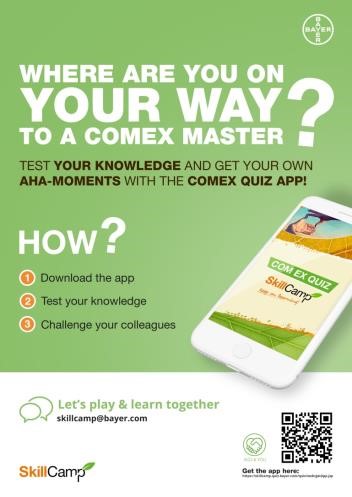
Figure 3: The Crop Science quiz app
Also our new design for SkillCamp online is optimized for mobile devices. As SkillCamp Online is the single point of reference for our SkillCamp learning framework, our colleagues can now access the whole SkillCamp portfolio on the go.
Gaming
Besides the above-mentioned quiz app we start integrating learning levels, role-based learning and badges into our personal learning paths of mySkillCamp for the individual learner.
We also use gaming elements in our ILT and VILT courses, e.g., quizzing or team challenges.
Self-evaluation
We have a basic SkillCheck to test marketing and sales knowledge on an anecdotal level. We currently prototype knowledge tests that help advance personal learning paths and can support discussions in the development dialogue of a learner. This will also be combined with the above mentioned badge concept.
Social
Our content can be rated and commented on. We are currently integrating this functionality into the Bayer social media platform (IBM Connections) in order to further enable sharing and connecting.
On top we have a connections community page that has a growing audience. We are also entertaining a global community of SkillCamp advocates who help us multiply and support learning within the SkillCamp framework.
Video
SkillCamp produces and uses short videos to illustrate key content elements in ILTs, VILTs, webinars, and our EPSS. We have our own SkillCamp video channel on the Bayer internal video streaming platform and have integrated the video search into our EPSS.
We are expecting rapid growth for video in the SkillCamp Learning framework over the next years.
Case study learning
We developed a virtual country called Algodonia to work on in our SkillCamp Foundational Training as well as other training formats. This extensive case study simulated the business situation of a sales driven company (Figure 4).
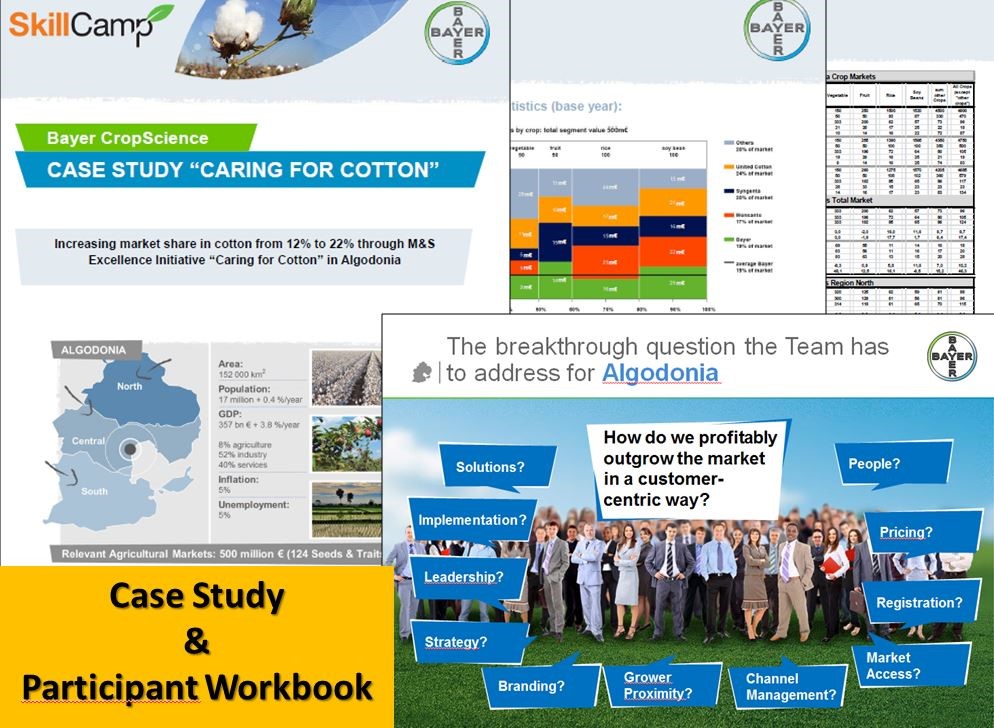
Figure 4: The Algodonia Case study was used in several blended formats, also as a workbook, accompanying ILTs
Besides this example, we work with an abundance of case studies, best practices, and examples from our own businesses as well as from universities or other learning partners.
Webinars
SkillCamp offers a catalogue of webinars every year, usually providing some theory, a case study or example of application, and group discussions within a one-hour timeframe. Webinars are provided in several time zones and languages. Registration and content are accessible in our EPSS.
Community learning
We are supporting a community of SkillCamp Advocates to multiply the SkillCamp learning framework. We also encourage and support group work in ILTs, VILTs, and webinars. Subject matter experts can be reached by any employee within our EPSS “SkillCamp Online.”
Role-based learning
At the end of 2016 we launched role-based support and content access in SkillCamp Online to support specific job roles in a very focused way. With this approach, we funnel defined content to specific target groups. This increases the usability for these target groups by reducing provided content to a needed minimum (Figure 5).
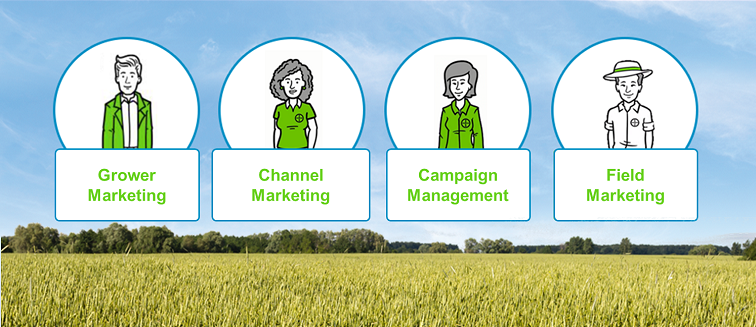
Figure 5: The specific target groups for SkillCamp Online
MySkillCamp and individual learning paths prototype
Every employee is single-signed-on to SkillCamp Online and can access the mySkillCamp area where, over time, she will find more and more personalization options to shape her individual learning path. For example, she can take notes or print out a summary of her functional learning activities to discuss them along with his/her development path with the manager. She can also, for example, review badges and recent activities.
Conclusions
SkillCamp—our functional blended and performance based learning ecosystem—works well to addresses our learners’ needs. See also my recent article on metrics.
We strongly believe that blended-learning approaches help make learning attractive and sticky.
We will keep exploring our mix of learning formats and make sure to optimize the content to the delivery modality. A blended learning philosophy will always be the base when we create a new learning format.
SkillCamp already covers many such formats. The combination, the link to the purpose for learning, and the way we present this mix to the learner are critical for the success.
Here are some more of our recent lessons learned:
- Clarify and keep clarifying:
As I wrote in my first article, it is important to clarify exactly what the objectives of the different stakeholders are in regard to a learning ecosystem. After four years our key messages proved right, however organizational changes, technological development, user needs, and exploding interest in this new approach lead to an ongoing need for clarification and modification of what SkillCamp should be, what it should deliver, and what it should not deliver. - Adding Social helps multiplying
As we start to integrate our communication as well as our content into our Bayer-wide social media platform we see a broader spread and growing use for our content. We do this in two ways: We host our own SkillCamp community site within the Bayer-wide Connections platform, and we provide community functionality like sharing, commenting, or rating directly with all our content in our EPSS. - Video is most effective as part of our SkillCamp EPSS structure
We receive more and more requests for video and have developed our own SkillCamp video concept. We launched a SkillCamp Video channel on our internal Bayer video platform. However, we positioned the search engine for the videos directly into our EPSS SkillCamp Online. This way we are able to find videos (for example, how-to videos) directly in our EPSS next to all our learning content, while benefiting from the advantage of hosting our videos on an optimized video streaming platform. - Customized or Individual learning paths are key
SkillCamp now has also started to personalize content for specific roles and for specific content areas.
The mySkillCamp Prototype goes one step further. It targets the individual and aims to anchor commercial excellence in career development and inspire M&S employees to enhance their competencies and to implement the company’s go-to-market strategy. MySkillCamp offers not only easy access to achieved learning levels and history but also an overview of available trainings, development options, and required competencies in a personalized dashboard.
Outlook
We are sure that the personalization trend will continue to shape blended learning and performance support more and more to the needs of the individual employee.
Our integrated quantitative EPSS metrics, SkillCamp objectives, and qualitative results will lead to far deeper understanding of our learners’ needs. At the same time this will help us to tie SkillCamp closer to our business objectives.
We are expecting even more demand for customized blended training and learning in the future.
Video will grow in the coming years and we are expecting rapid growth of “how-to” video demand.
We are also working hard on localizing SkillCamp approaches and content with the help of our SkillCamp Advocates. SkillCamp might become more of a global framework (Figure 6) with guidelines and even a policy that aim to make it easy to spread personalized learning based on blended learning and performance support principles into local, regional, and global units of our company.
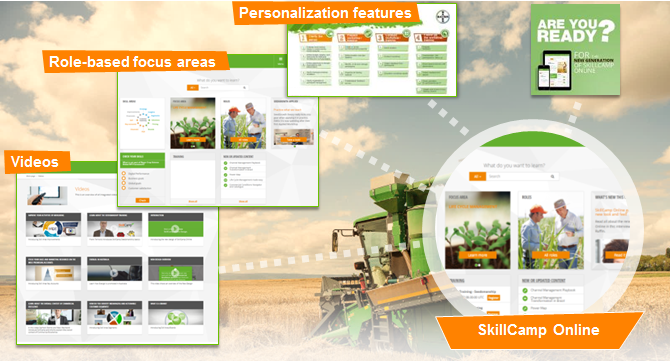
Figure 6:The potential global SkillCamp framework



